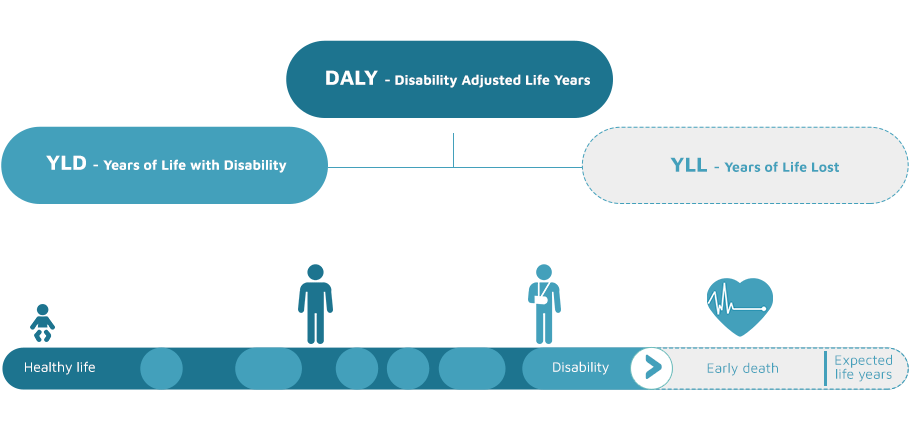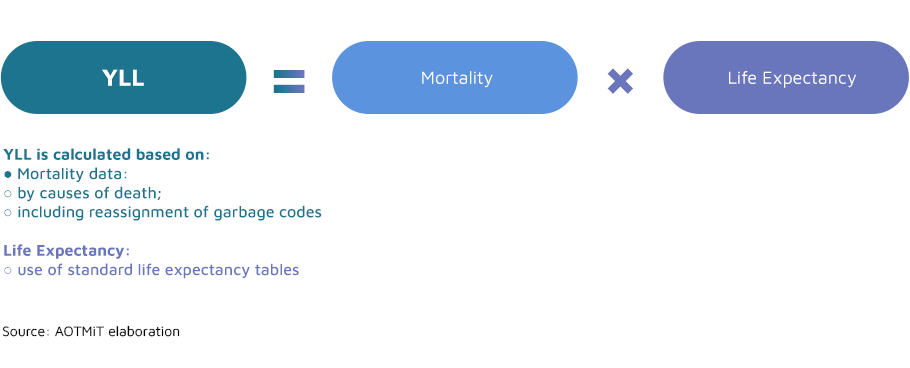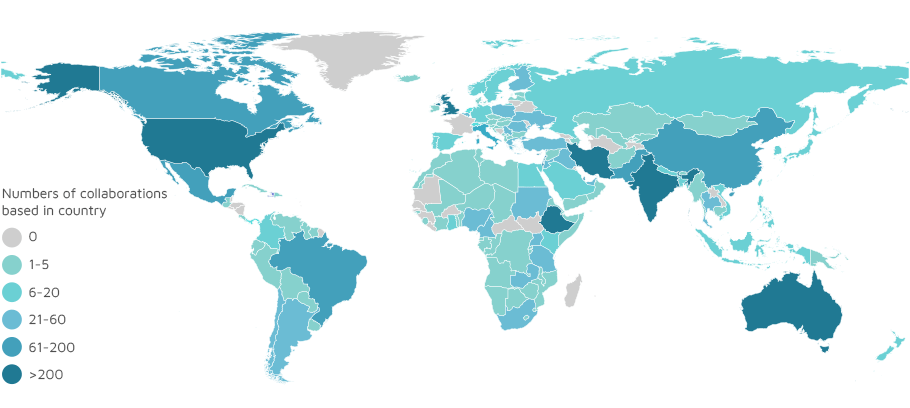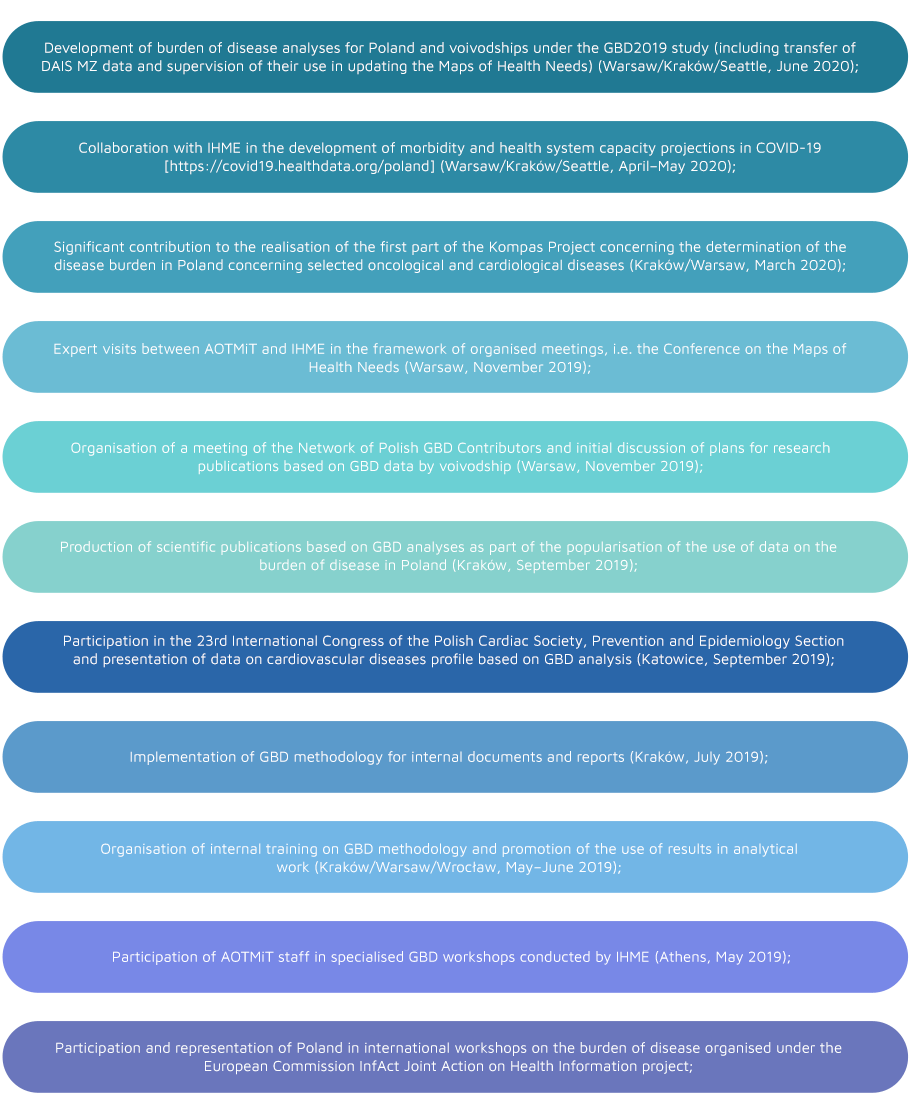![]()
GBD – Global (Polish) Burden of Disease
Project Reach
International – a collaboration that brings together a network of 4,590 health sector experts from 147 countries around the globe.
Project Objective
An international collaboration between the Agency for Health Technology Assessment and Tariff System and the Institute for Health Metrics and Evaluation (IHME) at the University of Washington in Seattle under
- development and implementation of Global Burden of Disease tools in the process of shaping central and regional evidence-based health policy in Poland (stage 1 – voivodships, stage 2 – counties);
- research cooperation in the context of application and dissemination of results of local GBD analysis.
Project Description
Global Burden of Disease Study – a research project directed at the possibility of quantifying health loss due to illnesses, injuries and risk factors affecting health through specific and standardised health measures, i.e. DALY, YLL,YLD.

Disability-Adjusted Life Year is the sum of years of life lost (YLL) due to premature mortality and the number of years of life with disability (YLD. Through the DALY measure, it is possible to estimate the severity (mortality and morbidity) of specific diseases and, consequently, the importance of the risk factors that cause them, the benefits of reducing the prevalence of the disease through prevention or treatment and, when converted into monetary values, the costs and benefits of specific interventions. One DALY represents the loss of the equivalent of one year of full health.
The DALY components take into account a number of variables dependent on age, sex, location and time. In a nutshell, these measures can be described as depicted below:
- YLL– a measure referring to the number of years of life lost due to premature mortality resulting from a disease. It considers two aspects, the number of deaths in a given group and life expectancy for the age at which death occurred. The life expectancy tables are the same for all regions of the world, giving standard, representative values;

- YLD – a measure describing the sum of years of life with disability due to illness or injury. It provides an objective assessment of the impact of a health problem on the health of a population in cases where it causes long-term health loss. It considers and values the spectrum of severity of illness and/or injury and the disability that is associated with it, given the average time of onset.
The role of the Agency for Health Technology Assessment and Tariff System
Since 2018, by virtue of a letter of intent, the role of partner and main coordinator of the process adapting the GBD methodology in the Polish health care system and the role of the GBD Centre is performed by the Agency for Health Technology Assessment and Tariff System, which, in cooperation with other bodies, i.e. the National Institute of Public Health – National Institute of Hygiene (NIPH-NIH) and the Department of Analysis and Strategy of the Ministry of Health (DAIS MZ), oversees the verification of input data and estimates in the current edition of GBD2019. Several actions have been taken together with these institutions to improve the quality of data describing the health situation in Poland.
The first was the inclusion of Poland in the group of countries for which sub-national analyses were performed in the subsequent GBD2019 study, thus showing differences in the health status of the population within the country and providing an opportunity to make comparisons thanks to the structured methodology of analysis, homogeneous for all analysed areas. Thanks to the cooperation with IHME, it was possible to update and reshape the Maps of Health Needs by the Ministry of Health, introducing analyses at the voivodship level for incidence, prevalence, mortality and disease burden estimates expressed in DALYs.
The GBD methodology is also present in a number of other documents and reports prepared independently by the Agency, always providing significant substantive added value. In the following years, further development of analytical, didactic and research cooperation is planned within the GBD Centre established at AOTMiT, which brings together a large group of experts in health care, statistics, economics, epidemiology and public health.
Goals of the GBD Research Centre
The intended tasks of the GBD Research Centre at the Agency for Health Technology Assessment and Tariff System include:
- coordination of cooperation between the institution developing the Global Burden of Disease Study in terms of collection and provision of input data as well as verification of estimates from subsequent editions of the GBD research project;
- implementation and supervision of the use of burden of disease estimation methods in the framework of population health assessment reporting and other documents prepared by AOTMiT containing burden of disease analyses at the central as well as regional level;
- research cooperation with an elite group of Polish and international scientists representing leading entities of the health care sector to co-create innovative publications and research projects;
- educational and training activities addressed to those involved in projects based on the GBD methodology and scientific exchange between IHME and the Centre;
- activities related to the popularisation of the GBD concept at conferences, expert meetings and international congresses on disease burden issues worldwide and in specific European regions;
- continuous work on new tasks and plans for the development of the Centre in the context of further studies and projects.
Successes and achievements of AOTMiT in the GBD so far
AOTMiT publications using GBD analyses
- Weszka A., Filipowicz K., Siwiec J., Topór‑Mądry R.: Wydatki na ochronę zdrowia w latach 1995–2050 w ujęciu globalnym – oszacowania Global Burden of Disease. Med. Prakt., 2019; 9. (Weszka A., et al., Global health expenditures from 1995 to 2050 – Global Burden of Disease estimates. Med. Pract., 2019; 9)
- Topór-Mądry R. et.al., Główne problemy dotyczące zdrowia Polaków w świetle najnowszych wyników badania Global Burden of Disease Study(GBD) 2017, [w]: Sytuacja Zdrowotna Ludności Polski i jej uwarunkowania, red. Wojtyniak B., NZIP-PZH, Warszawa, 2018 (Topór-Mądry R. et.al., The main health issues of Poles in the context of the latest results of the global burden of disease study (GBD) 2019, [in] Health Status Of Polish Population And Its Determinants 2020, edited by Wojtyniak B., Goryński P., Warsaw, 2021)
- XXIII Międzynarodowy Kongres Polskiego Towarzystwa Kardiologicznego, Sesja Sekcji Prewencji i Epidemiologii PTK, Topór-Mądry et al., Co każdy kardiolog powinien wiedzieć o zdrowiu Polaków: analizy „Global Burden of Disease”?; [prezentacja multimedialna]; (26 września 2019) (XXIII International Congress of the Polish Society of Cardiology, Session of the Prevention and Epidemiology, Topór-Mądry et al, “What should every cardiologist know about the health of Poles: analyses of Global Burden of Disease?”; [multimedia presentation]; (September 26, 2019))
*Ladies and Gentlemen
We inform you that the materials and results of the discussions posted on the Agency’s website are the result of the conceptual work and analytical process carried out by the team of the Agency for Health Technology Assessment and Tariff System based on the EBM paradigm, including: search, selection, synthesis and interpretation of scientific evidence, or the data analysis carried out.
In connection with the above, we would like to inform you that the use of analytical material or the results of the discussion, in accordance with good practice, should be accompanied by information on the source in the form: [title of presentation / report], AOTMiT, Warsaw, June 2021]



